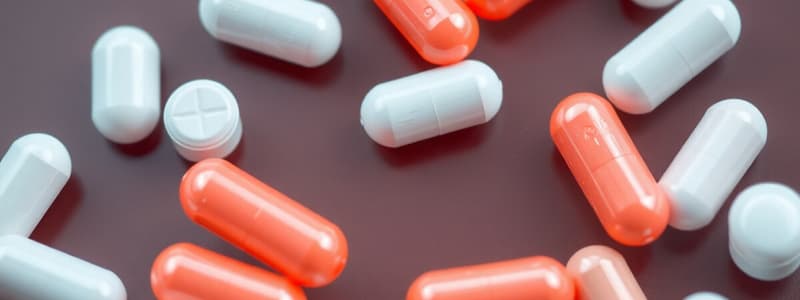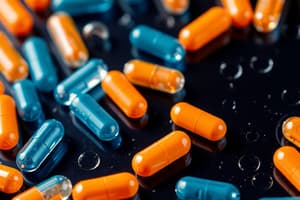Podcast
Questions and Answers
Which of the following explains the mechanism of action of amoxicillin?
Which of the following explains the mechanism of action of amoxicillin?
- Inhibition of the formation of the new cell wall. (correct)
- Disruption of the bacterial cell membrane.
- Interference with bacterial DNA replication
- Irreversible inhibition of protein synthesis.
A patient is prescribed amoxicillin for a bacterial infection. The patient is also taking an antacid containing metal ions. What is the likely effect on amoxicillin's absorption?
A patient is prescribed amoxicillin for a bacterial infection. The patient is also taking an antacid containing metal ions. What is the likely effect on amoxicillin's absorption?
- No significant change in amoxicillin absorption.
- Decreased absorption of amoxicillin. (correct)
- Accelerated metabolism of amoxicillin.
- Increased absorption of amoxicillin.
A patient develops a rash and pruritus after starting amoxicillin. This adverse drug reaction is most likely due to:
A patient develops a rash and pruritus after starting amoxicillin. This adverse drug reaction is most likely due to:
- Nephrotoxicity.
- Ototoxicity.
- Anaphylaxis.
- Allergic reaction. (correct)
A bacterial strain exhibits resistance to amoxicillin due to the production of beta-lactamases. How do beta-lactamases contribute to this resistance?
A bacterial strain exhibits resistance to amoxicillin due to the production of beta-lactamases. How do beta-lactamases contribute to this resistance?
A patient being treated with gentamicin develops tinnitus and hearing loss. What is the most likely explanation for these symptoms?
A patient being treated with gentamicin develops tinnitus and hearing loss. What is the most likely explanation for these symptoms?
Which statement best describes why gentamicin is typically administered parenterally?
Which statement best describes why gentamicin is typically administered parenterally?
A patient is prescribed tetracycline for acne. The patient is also taking a calcium supplement. What is the potential interaction between tetracycline and calcium?
A patient is prescribed tetracycline for acne. The patient is also taking a calcium supplement. What is the potential interaction between tetracycline and calcium?
Which of the following statements correctly describes the mechanism of aminoglycosides?
Which of the following statements correctly describes the mechanism of aminoglycosides?
How do bacteria typically develop resistance to tetracycline?
How do bacteria typically develop resistance to tetracycline?
Why are tetracyclines contraindicated in children and pregnant women?
Why are tetracyclines contraindicated in children and pregnant women?
Flashcards
Penicillins
Penicillins
A class of antibiotics originally derived from Penicillium chrysogenum. They contain a beta-lactam ring.
Penicillins MOA
Penicillins MOA
The mechanism of action involves inhibiting the formation of the bacterial cell wall, leading to bacterial cell death.
Amoxicillin
Amoxicillin
A type of penicillin with a broad spectrum of activity, effective against a wide range of bacteria. Administered orally and distributes readily.
Penicillin Resistance
Penicillin Resistance
Signup and view all the flashcards
Aminoglycosides
Aminoglycosides
Signup and view all the flashcards
Gentamicin
Gentamicin
Signup and view all the flashcards
Tetracyclines
Tetracyclines
Signup and view all the flashcards
Tetracycline Examples
Tetracycline Examples
Signup and view all the flashcards
Tetracycline Spectrum
Tetracycline Spectrum
Signup and view all the flashcards
Tetracycline Resistance
Tetracycline Resistance
Signup and view all the flashcards
Study Notes
- Focus is on the pharmacology of amoxicillin, gentamicin, and tetracyclines.
- The following points will be covered: chemistry, mechanism of action, spectrum of activity, pharmacokinetics, and development of resistance for each drug.
Penicillins
- Originally derived from Penicillium chrysogenum, a fungus.
- Consist of a beta-lactam ring, which is responsible for the drug's activity.
- Amoxicillin is an example.
- The mechanism of action involves inhibiting the formation of the new cell wall, making it bactericidal.
- Benzylpenicillin (Pen G) has a narrow spectrum
- Amoxicillin has a broad spectrum
- Clinical applications include: UTI, syphilis, typhoid fever, rheumatic fever, bacterial endocarditis, etc.
- Amoxicillin is administered orally.
- It is readily distributed into body fluids and can cross the placenta.
- Excreted mainly unchanged renally.
- Resistance develops through the breaking of the beta-lactam ring by beta-lactamases produced by bacteria.
- Generally safe, but can cause allergic reactions such as rashes, pruritus, and anaphylaxis.
Aminoglycosides
- Gentamicin is an example.
- Polar compounds containing amino sugars, like Streptomycin.
- Irreversibly inhibits protein synthesis, and is bactericidal.
- Effective against aerobic bacteria.
- Clinical applications: Mycobacterial and Staphylococcal infections.
- High polarity, therefore it does not allow for passage across membranes
- Usually given parenterally
- Does not penetrate cells and tissues
- However, concentrate into renal cortical tissue, endolymph, and perilymph.
- Low PPB
- Excreted unchanged renally.
- Low TI
- Can cause pain at the injection site.
- Nephrotoxicity after one week of administration (reversible with discontinuation).
- Ototoxic (degeneration of auditory fibers, tinnitus, deafness).
- NMJ blockage-decrease Ach release
- Allergic reactions like rashes and fever can occur.
- Resistance develops as transferases in bacteria break down the drug.
Tetracyclines
- Chemistry: Four-member ring compounds.
- Examples: Tetracycline, Minocycline.
- It reversibly inhibits protein synthesis, which is bacteriostatic.
- Its spectrum of activity is broad.
- Clinical applications include Chlamydia, Cholera, Rickettsia, and Propionibacterium (Acne).
- Well absorbed from the gastrointestinal tract (GIT).
- Absorption is affected by food and metal ions (least affected for minocycline).
- Also can be given intravenously
- High lipid solubility.
- It generally accumulates well in body fluid and tissues.
- Peak serum levels reached in 2 hours.
- Low accumulation in CSF and crosses the placenta.
- Chelates with metal ions, and calcium.
- Excreted unchanged renally.
- Can have adverse drug reactions like polyuria and photosensitivity.
- Contraindicated in children and during pregnancy.
- Hepatotoxicity in pregnancy can be fatal.
- Superinfections such as diarrhea, thrush, and vaginal candidiasis can occur.
- Resistance develops through increased efflux and decreased influx of the drug.
Studying That Suits You
Use AI to generate personalized quizzes and flashcards to suit your learning preferences.




